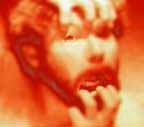
I keep an electric guitar and an amp next to my computer whenever I can. Five years ago, while working at the SF Examiner, I purchased a cheap acoustic Fender guitar from the pawnshop around the corner to leave beside my desk for anyone who might pick it up in need of those moments that require the inner solitude and introspection a guitar can bring in a place of chaos. Several months after I’d left, a former co-worker told me what she missed most was the quiet sound of the guitar while she wrote her daily quota of news.
My guitars and amps give me great pleasure. I’m especially pleased with the instruments I've managed to rescued from dis(re)pair. Pictured above are a Gibson The Paul and a mid-60s Fender Showman cabinet I was able to resuscitate. The Hi-Mu 5.5 amplifier is another story, it came to me whole and full of life.
I purchased the Gibson for $125 when I was working as a production artist for the SF Weekly back in the late 1990s. It was cheap because someone had started to dismantle it for future improvement.
The future turned out to be too far away for the fellow that started the project.
Originally the guitar was black but when I received it the former owner had scraped off most of former paint. The pickups and other hardware also were random replacements so I didn’t have any hesitation finishing his strip job, re-contouring the body, adding an after market mother of pearl headstock logo, refinishing the guitar in antique cherry, replacing the pickups with Fralin humbuckers and the hardware with vintage original gold plated Gibson equipment. It’s not collectible but with a decent set of strings it sings and looks good.
The Fender cabinet, sans speakers, was a similar find for $50 on Craigslist. A pair of inexpensive and dysfunctional mid 60s Jensen 15 speaker were sent to Audiovex for re-coning with Celestion Greenback cones and for less than $200 I had a great sounding if a tad ugly cabinet. Someday I'll recover it in new tolex.
The Hi-Mu wasn’t so easy, but then again, it didn't need anything. Using my research skills I traced down the original builder, Barry Breisch, at home. He stopped building amps in the late 1990s but it turned out he no longer was playing his personal amp and offered to sell it to me for a reasonable price. It arrived in immaculate condition, as though it had been carefully lost in the mails in the mid-90s and magically arrived on my doorstep a decade late.
Not a day goes by that I don’t turn the amp to ten, the guitar to a similar level, and create a quiet empty peace in my head, letting the amazing, cleansing sound wash over me. It’s renewing in a way that only holy music played loudly can be.
This post was originally written for my other blog, which is typically about politics. If you're interested in a LIBERAL perspective on the world you are welcome to check it out at www.tourettesdujour.blogspot.com
Be well and live in peace.













